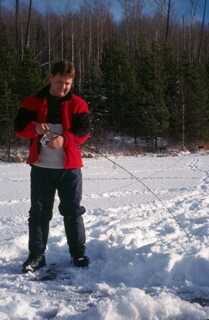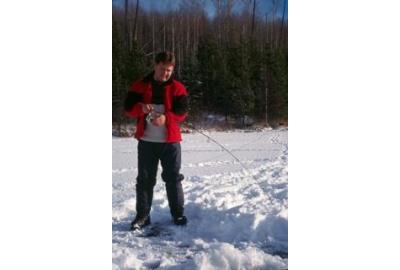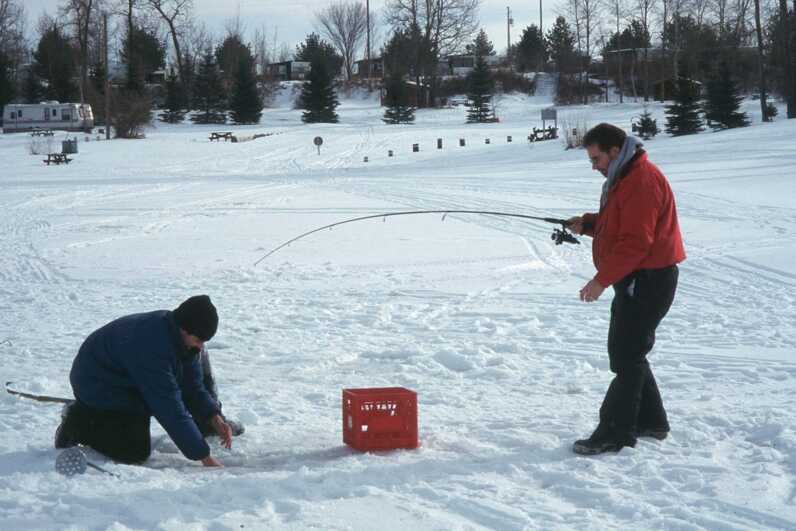The change over from March 31st to April 1st completely redefines the angling landscape. Where many pike, walleye and whitefish lakes were open March 31st, come April 1st most all of them are closed. Given this, for those of us still eager to hit the ice and catch a fish, our best bet is to chase trout. Almost every trout lake near and far remains open year round however local regulations should be reviewed before setting out. The upside is that some of the best ice fishing happens through April.


April days are meant for fishing. There’s plenty of heat in the sun and with longer more intense sunlight, the weeds start growing, the bugs start moving and the fish start feeding. The food chain gets kicked up a notch in and you can be sure that I’ll be right there to meet it.
In Alberta we are allowed to ice fish with two lines and I take full advantage of this rule. For the first line I’ll deploy a setline where I’ll drop a lively trout worm over 5 – 8 feet of water near weeds. I’ll set this up 50 or so feet away from where I’ll be fishing with my second line so as not to disturb it too much. I will actively jig with my second line and hop from hole to hole. I cut 10 or more holes ranging from 4 to 20 feet deep and spend a few minutes jigging in each one.
When I first start jigging I’m aggressive with a small lead head jig with a black body. I’ll drop it to the bottom, wiggle it a few seconds then slowly lift. I get a lot of bites on the lift.
If I get real fancy, I’ll tip the end of the jig with a small piece of worm, however most times I don’t. I give each hole a few minutes and then hop to the next one. The jig is super effective at getting the aggressive bites and on some spring days this bite can last a good chunk of the day.
Once I’ve covered all the holes and possibly touched off on all the aggressive fish, there will still be a bunch that will be opportunistic and still available to be caught. I’ll then switch over and go into stealth mode by pulling out the nymphs. My favorites are the bead head pheasant tail nymph, the wooly worm and the full back nymph, all in the smaller sizes. I’ll drop them down and watch them. The bites are frequent and they happen all day long. Jigging a small fly is about as deadly as it comes. The key is to watch closely as many trout will come in, inhale the fly then spit it out without ever giving a yank or jerk on the line. If I wasn’t watching, I wouldn’t have picked up the bite or the fish.
The watching is a whole lot of fun. Often time I’ve looked down holes to see monstrous trout cruise right up and suck in the fly. That’s a real hoot. And now I’ve taken to drilling two holes side by side so both my daughter and I can see the same fly down the hole and watch the fish come in and eat it. It’s really added to our fishing experience. I can also say this technique works equally well when fishing for whitefish.
To work the fly, send it all the way to the bottom and slowly move it all the way up to the edge of the ice hole. Give it some small jerks or twitches, but you don’t have to get too carried away to attract a bite. When you see your first trout you can either stop the fly entirely and let him suck it in or, slowly and deliberately raise the fly. The fish will tip up and suck it in. They’re both very effective techniques.
You will amaze yourself at how many trout will suddenly appear a couple feet below the hole and bite the fly, even if it’s ten feet deep. On some days, I’ve had most of my bites near the top of the column. If you find this happening you can also move your set line up high and double your fish catching.
So there you have it. For all you anglers that were faithfully hitting the whitefish, walleye, perch and pike lakes, a switch over to trout can extend your season and add variety to your fishing experiences. For those that fish trout, I’m sure your smiles are getting bigger by the day, because we both know the best fishing of the ice season is upon us.






